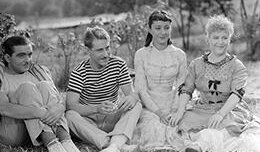|
|
| Tookey's Review |
|
| Pro Reviews |
|
| Mixed Reviews |
|
| Anti Reviews |
|
| Cast |
|
| |
 |
| |
| Released: |
1946 |
| |
|
| Genre: |
DRAMA
FOREIGN
ROMANCE
COMEDY
|
| |
|
| Origin: |
France |
| |
|
| Colour: |
BW |
| |
|
| Length: |
40 |
|
| |
|
| |
|
|
| |
|
|
A 19th century Parisian petit-bourgeois family picnics in the country, and the daughter Henriette (Sylvie Bataille) has a (very) brief love affair with a more upper-class holiday-maker Henri (George Darnoux).
|
Reviewed by Chris Tookey
|
|
Though this is an unfinished masterpiece, it is only two scenes short of the one-hour film which Renoir intended it to be. (A rainy summer in 1936 led to Renoir becoming disillusioned and abandoning the project to start on Les Bas-Fonds) However, the missing scenes - one setting up the heroine Henriette’s lower middle-class family before they go on their day trip, the other covering the visit of the hero Henri to Paris in order to discover what happened to Henriette - are hardly missed. The film as it stands makes perfect sense with two additional titles, added in 1946.
|
|
The only print of the film was destroyed by the Nazis in World War II, but a new version (and, so it is said, a better one) was compiled from the negative after the war. First shown ten years after it was shot, the film has been delighting audiences ever since with its mixture of wit and sensuality. It's a lyrical, romantic vision of rural France, full of nostalgia for lost love.
|
|
The look of the piece is indebted to the impressionists, and both Jean Renoir’s father Auguste and Alfred Sisley had lived nearby. Renoir chose the location because he knew it so well: “I knew what time the light would be hitting a specific group of tres in a particularly pleasing way. I new even the smallest details of the landscape.”
|
|
The fact that the film was shot on location, with a constantly panning and tracking camera, marks it out as very different from the relatively stagey Hollywood movies of its period. The moment when a window swings back to show the heroine on a swing is one of the greatest emotional coups in cinema (note, too, that Renoir’s use of deep focus predates Gregg Toland and Orson Welles). Joseph Kosma’s score, added long after Renoir had left the project, is one of his loveliest.
|
|
Renoir thought little of his abandoned film after he had left France for America in 1940, and did not even include it among his works when he compiled a list of them at that time.
|
|
Shooting it was far from the idyll that Renoir later pretended it had been.
|
|
Bad weather ensured there was a lot of waiting around, and drunkenness. Sylvia Bataille quarrelled publicly with Renoir when he allowed himself to go off for a week, but wouldn’t allow her to go to Paris for a day. They never worked together again, and her career never recovered.
|
|
The film is much less obviously political than Renoir’s other work of the 1930s, but there is still an emphasis on class as the great divider. And Renoir’s abiding fascination with water as a symbol of escape, nourishment and inexorable fate was never more beautifully expressed.
|
|
Is the film perfection? Not quite. Some of the performances are a a shade broad and theatrical for my taste. I’m never quite convinced that Henriette would ever have married the buffoonish Anatole, who is a little bit too much like a coarser Stan Laurel for comfort.
|
|
But the central moments are genuinely affecting, Renoir’s tribute to the countryside he loved is heartfelt. The bitter side of de Maupassant’s story survives, but it is made more palatable by Renoir’s instinctive humanity and sympathy. Whether or not this is Renoir’s finest film, it is certainly one of my favourites: evocative, lyrical, sad yet joyous, and much deeper than it seems on the surface.
|
|
Note: Jean Renoir makes a cameo appearance as the innkeeper Monsieur Poulain in a moustache and silly hat.
|
|
|
|
|
